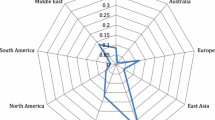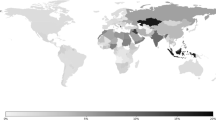Abstract
Using a database of potential, possible, or probable predatory scholarly open-access journals, the objective of this research is to study the penetration of predatory publications in the Brazilian academic system and the profile of authors in a cross-section empirical study. Based on a massive amount of publications from Brazilian researchers of all disciplines during the 2000–2015 period, we were able to analyze the extent of predatory publications using an econometric modeling. Descriptive statistics indicate that predatory publications represent a small overall proportion, but grew exponentially in the last 5 years. Departing from prior studies, our analysis shows that experienced researchers with a high number of non-indexed publications and PhD obtained locally are more likely to publish in predatory journals. Further analysis shows that once a journal regarded as predatory is listed in the local ranking system, the Qualis, it starts to receive more publications than non-predatory ones.




Similar content being viewed by others
Notes
See AJE research report for Brazilhere.
An ISSN is structured as XXXX-XXXY, where X is any number and Y is a number or a text.
The model is estimated using R package glmmML (Brostrm 2017).
The results for all rankings are very comparable, with matching coefficient signs and significance. However, the absolute value decreases significantly.
References
Abbasi, K. (2012). The debate around open-access publishing. Journal of the Royal Society of Medicine, 105, 185.
Abramo, G., Cicero, T., & DAngelo, C. A. (2015). Should the research performance of scientists be distinguished by gender? Journal of Informetrics, 9(1), 25–38.
Al-Khatib, A. (2016). Protecting authors from predatory journals and publishers. Publishing Research Quarterly, 32(4), 281–285.
Beall, J. (2012). Predatory publishers are corrupting open access. Nature, 489(7415), 179.
Beall, J. (2013). Medical publishing triage-chronicling predatory open access publishers. Annals of Medicine and Surgery, 2(2), 47–49.
Beall, J. (2015a). Criteria for determining predatory open-access publishers. http://publica.upc.edu/sites/default/files/arxius_site/criteris_editorials_fraudulentes.pdf. Accessed 5 May 2017.
Beall, J. (2015b). Predatory journals and the breakdown of research cultures. Information Development, 31(5), 473–476.
Beall, J. (2017). What i learned from predatory publishers. Biochemia Medica: Biochemia Medica, 27(2), 273–278.
Berger, M., & Cirasella, J. (2015). Beyond Beall’s list better understanding predatory publishers. College and Research Libraries News, 76(3), 132–135.
Bowman, J. D. (2014). Predatory publishing, questionable peer review, and fraudulent conferences. American Journal of Pharmaceutical Education, 78(10), Article 176.
Brooks, C., Fenton, E. M., & Walker, J. T. (2014). Gender and the evaluation of research. Research Policy, 43(6), 990–1001.
Brostrm, G. (2017). glmmML: Generalized linear models with clustering. https://CRAN.R-project.org/package=glmmML, r package version 1.0.2.
Butler, D. (2013). The dark side of publishing. Nature, 495(7442), 433.
Clark, A. M., & Thompson, D. R. (2016). Five (bad) reasons to publish your research in predatory journals. Journal of Advanced Nursing. https://doi.org/10.1111/jan.13090.
Djuric, D. (2015). Penetrating the omerta of predatory publishing: The Romanian connection. Science and Engineering Ethics, 21(1), 183–202.
Frandsen, T. F. (2017). Are predatory journals undermining the credibility of science?A bibliometric analysis of citers. Scientometrics. https://doi.org/10.1007/s11192-017-2520-x.
Gujarati, D. N. (2009). Basic econometrics. New York: Tata McGraw-Hill Education.
Haug, C. (2013). The downside of open-access publishing. New England Journal of Medicine, 368(9), 791–793.
Kulczycki, E. (2017). The rise of predatory journals: The case of Dr. Anna fraud. NAUKA, 1(3), 71–83.
Laakso, M., Welling, P., Bukvova, H., Nyman, L., Björk, B. C., & Hedlund, T. (2011). The development of open access journal publishing from 1993 to 2009. PLoS ONE, 6(6), e20,961.
Lukić, T., Blešić, I., Basarin, B., Ivanović, B. L., Milošević, D., & Sakulski, D. (2014). Predatory and fake scientific journals/publishers: A global outbreak with rising trend: A review. Geographica Pannonica, 18(3), 69–81.
Manca, A., Martinez, G., Cugusi, L., Dragone, D., Dvir, Z., & Deriu, F. (2017a). The surge of predatory open-access in neurosciences and neurology. Neuroscience, 353, 166–173.
Manca, A., Martinez, G., Cugusi, L., Dragone, D., Mercuro, G., & Deriu, F. (2017b). Predatory open access in rehabilitation. Archives of Physical Medicine and Rehabilitation, 98(5), 1051–1056.
Nwagwu, W. E. (2016). Open access in the developing regions: Situating the altercations about predatory publishing/l’accès libre dans les régions en voie de développement: Situation de la controverse concernant les pratiques d’édition déloyales. Canadian Journal of Information and Library Science, 40(1), 58–80.
Omobowale, A. O., Akanle, O., Adeniran, A. I., & Adegboyega, K. (2014). Peripheral scholarship and the context of foreign paid publishing in nigeria. Current Sociology, 62(5), 666–684.
Perlin, M. (2017). Predatory: Tools for detecting predatory publishers and journals. https://CRAN.R-project.org/package=predatory, r package version 1.2.
Perlin, M. S., Santos, A. A., Imasato, T., Borenstein, D., & Da Silva, S. (2017). The Brazilian scientific output published in journals: A study based on a large cv database. Journal of Informetrics, 11(1), 18–31.
Piro, F. N., Aksnes, D. W., & Rrstad, K. (2013). A macro analysis of productivity differences across fields: Challenges in the measurement of scientific publishing. JASIST, 64, 307–320.
Pyne, D. (2017). The rewards of predatory publications at a small business school. Journal of Scholarly Publishing, 48(3), 137–160.
Rørstad, K., & Aksnes, D. W. (2015). Publication rate expressed by age, gender and academic position-a large-scale analysis of Norwegian academic staff. Journal of Informetrics, 9(2), 317–333.
Shen, C., & Björk, B. C. (2015). ’Predatory’ open access: A longitudinal study of article volumes and market characteristics. BMC Medicine, 13(1), 1.
Shuva, N. Z., & Taisir, R. (2016). Faculty members perceptions and use of open access journals: Bangladesh perspective. IFLA Journal, 42(1), 36–48.
Sorokowski, P., Kulczycki, E., Sorokowska, A., & Pisanski, K. (2017). Predatory journals recruit fake editor. Nature, 543, 481–483.
Strielkowski, W. (2017). Predatory publishing: What are the alternatives to beall’s list? The American Journal of Medicine. http://www.sciencedirect.com/science/article/pii/S0002934317311968.
Van Noorden, R. (2013). Brazilian citation scheme outed. Nature, 500(7464), 510–1.
Wallace, F. H., & Perri, T. J. (2018). Economists behaving badly: Publications in predatory journals. Scientometrics. https://doi.org/10.1007/s11192-018-2690-1.
Xia, J. (2015). Predatory journals and their article publishing charges. Learned Publishing, 28(1), 69–74.
Xia, J., Harmon, J. L., Connolly, K. G., Donnelly, R. M., Anderson, M. R., & Howard, H. A. (2015). Who publishes in “predatory” journals? Journal of the Association for Information Science and Technology, 66(7), 1406–1417. https://doi.org/10.1002/asi.23265.
Author information
Authors and Affiliations
Corresponding author
Rights and permissions
About this article
Cite this article
Perlin, M.S., Imasato, T. & Borenstein, D. Is predatory publishing a real threat? Evidence from a large database study. Scientometrics 116, 255–273 (2018). https://doi.org/10.1007/s11192-018-2750-6
Received:
Published:
Issue Date:
DOI: https://doi.org/10.1007/s11192-018-2750-6




